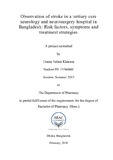| dc.contributor.advisor | Kabir, Tanvir | |
| dc.contributor.author | Khanam, Umme Salma | |
| dc.date.accessioned | 2018-07-03T10:30:18Z | |
| dc.date.available | 2018-07-03T10:30:18Z | |
| dc.date.copyright | 2018 | |
| dc.date.issued | 2018-02 | |
| dc.identifier.other | ID 13346046 | |
| dc.identifier.uri | http://hdl.handle.net/10361/10308 | |
| dc.description | This project report is submitted in partial fulfilment of the requirements for the degree of Bachelor of Pharmacy, 2018. | en_US |
| dc.description | Catalogued from PDF version of project report. | |
| dc.description | Includes bibliographical references (page 61-69). | |
| dc.description.abstract | Stroke is a frequently occurring acute cerebrovascular event which is characterized by blood vessel disruption in the brain. We sought to represent the risk factors, symptoms and treatment strategies of stroke in Dhaka, Bangladesh. A prospective, observational and spontaneous reported survey study was carried out among 200 stroke patients who were receiving treatment during study, from national institute of neurosciences and hospital (NINSH), Dhaka, Bangladesh. A case report form (CRF) comprised of questions was formed and obtained data were analyzed and presented by GraphPad Prism version 7. Majority of the patients were male with a percentage of 57.5% and female were 42.5%. Stroke was seen more prevalent in age group of 61-70 years old and 66.5% patients were from rural areas. Hemorrhagic stroke was found in 74.5% cases, ischemic stroke in 24% cases and both ischemic and hemorrhagic stroke were found in 1.5% cases. Hypertension (63.5%) was the commonest risk factor and vomiting (53%) was the top most symptom associated with both types of stroke. The most common forms of diagnosis were computed tomography (CT) scan (100%), complete blood count (CBC) (79.5%), serum electrolyte test (94%), serum creatinine test (89.5%), echocardiography (ECG) (73.5%) and urine examination (68.5%). In terms of treatment strategies, patients were receiving different types of anti-hypertensive agents (90%), anti-bacterial drugs (89%), corticosteroids (76.5%), anti-platelet drugs (21%), cholesterol-lowering agents (27%), anti-epileptic drugs (47.5%), anti-psychotic drugs (25.5%), anti-pyretic drugs (50%) and anti-emetic drugs (26.5%). The burden of stroke can be reduced by targeting these risk factors. Recognition of symptoms and contacting to physician without any delay can also alleviate the rate of disability and mortality. | en_US |
| dc.description.statementofresponsibility | Umme Salma Khanam | |
| dc.format.extent | 69 pages | |
| dc.language.iso | en | en_US |
| dc.publisher | BRAC Univeristy | en_US |
| dc.rights | BRAC University project reports are protected by copyright. They may be viewed from this source for any purpose, but reproduction or distribution in any format is prohibited without written permission. | |
| dc.subject | Transient ischemic stroke | en_US |
| dc.subject | Hemorrhagic stroke | en_US |
| dc.subject | Neurosurgery hospital | en_US |
| dc.title | Observation of stroke in a tertiary care neurology and neurosurgery hospital in Bangladesh: risk factors, symptoms and treatment strategies | en_US |
| dc.type | Project report | en_US |
| dc.contributor.department | Department of Pharmacy, BRAC University | |
| dc.description.degree | B. Pharmacy | |

